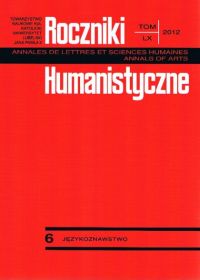On Non-Core Arguments and Dative Case in Polish
Abstract
This paper is concerned with the mechanics of the case assignment in Polish SIĘ construction with the overt dative nominal. It is argued that dative case on such nominals is assigned structurally by a high applicative head, not idiosyncratically by a lexical one. The preliminary analysis shows that most arguments carrying dative case in Polish display similar syntactic behavior with regards to e.g. passivization and control of depictive predicates. Due to their properties and to the way in which they are introduced into the structure, it is postulated that dative nominals should be best treated as the so-called non-core arguments that is arguments not selected by the verbal head. As for accusative case, it is assumed, following McFadden (2004), that its assignment hinges on the presence of another argument within the same phase to which structural case has been assigned. This other argument in the case of the SIĘ construction in question is the dative nominal.
References
Abraham W.: Datives: structural vs. inherent – abstract vs. morphological – autonomous vs. combinatory – universally vs. language-specifically configured?, in: Datives and other cases: between argument structure and event structure, ed. by D. Hole, A. Meinunger, W. Abraham, Amsterdam 2006, p. 3-46.
Blume K.: A contrastive analysis of interaction verbs with dative complements, „Linguistics” 36(1998), p. 253-280.
Burzio L.: Italian Syntax, Dordrecht 1986.
Chomsky N.: Lectures on government and binding: the Pisa lectures,Dordrecht 1981.
Dowty D.: Thematic proto-roles and argument selection, „Language” 67(1991), v. 6, p. 547-619.
Dziwirek K.: Polish Subjects, New York 1994.
Fassi Fehri A.: Arabic silent pronouns, person and voice, „Brill’s Annual of Afroasiatic Languages and Linguistics” 1(2009), p. 1-38.
Kibort A.: Passive and passive-like constructions in Polish. Doctoral dissertation, University of Cambridge, Cambridge 2004. Retrieved from http://ak243.user.srcf.net/pdfs/AnnaKibortThesis.pdf on 12.9. 2010.
Kratzer A.: Severing the external argument from its verb, in: Phrase structure and the lexicon, ed. by J. Rooryck, L. Zaring, Dordrecht 1996, p. 109-138.
Marantz A.: Case and Licensing, „ESCOL: Proceedings of the Eighth Eastern States Conference on Linguistics”, Ohio State University Department of Linguistics 1991, p.234-253.
McFadden T.: The position of morphological case in the derivation: A study on the syntax-morphology interface. Doctoral Dissertation, University of Pennsylvania, Philadelphia 2004. Retrieved from http://www.hum.uit.no/a/mcfadden/downloads/diss.pdf on 01.01.2012.
McFadden T.: German inherent datives and argument structure, in: Datives and other cases: between argument structure and event structure, ed. by D. Hole, A. Meinunger, W. Abraham, Amsterdam 2006, p. 47-78.
McFadden T. & Sundaresan S.: Nominative case is independent of finiteness and agreement, Retrieved from http://www.hum.uit.no/a/mcfadden/papers.htmlon 01.01.2012.
Pylkkänen L.: Introducing arguments, Cambridge Massachusetts 2008.
Rivero M-L., Arregui A., & Frąckowiak E.: Variation in circumstantial modality: Polish vs St’at’imects, „Linguistic Inquiry” 41(2010), v. 4, p. 704-714.
Sigurðsson H.: Case: abstract vs. morphological, in: New perspectives on case theory, ed. by E. Brandner, H. Zinsmeister, Stanford 2003, p. 223-268.
Sigurðsson H.: On a new passive, „Syntax” 14(2011), v. 2, p. 148-178.
Copyright (c) 2012 Roczniki Humanistyczne

This work is licensed under a Creative Commons Attribution-NonCommercial-NoDerivatives 4.0 International License.





